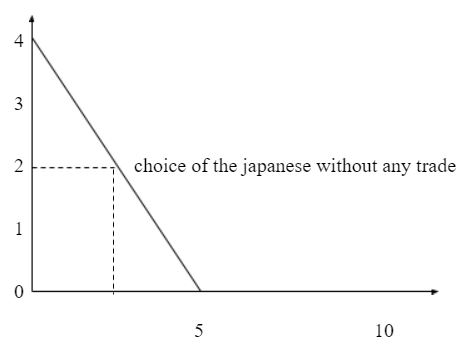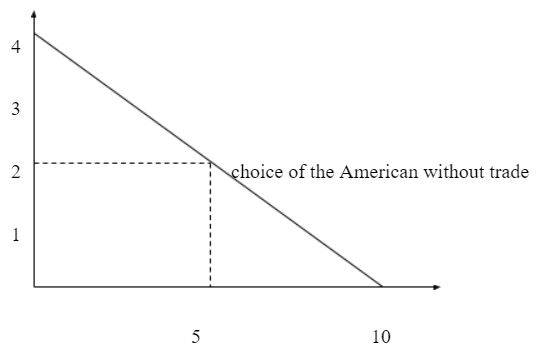Japanese production frontier

American Frontier

The opportunity cost of producing a car in America is equivalent to the foregone production of 2.5 tons of grains. It means that an American has to forego producing two and a half tons of grains in order to produce a single car. An American would also forego producing 0.4 parts of a car to produce I ton of grain. This means that an American should focus on producing grains in place of cars. In Japan’s case, the opportunity cost of producing a car is equal to foregoing the production of 1.25 tons of grains. The opportunity cost of producing 1 ton of grains is equivalent to the production of 0.8 parts of a car. Looking at the differences and the competition from America, a Chinese worker should focus on producing cars.
Part D
America has an absolute advantage of producing grains over China, mainly because of the emphasis on agriculture, availability of resources and presence of ample land to produce grains. In addition, the country has favorable climate and soil, which are important factors in the production of grains. China has an absolute advantage of producing cars. The availability of minerals gives the country an advantage over America. The minerals provide relevant metals and resources for manufacturing cars.
Part E
China has a comparative advantage in producing cars given that its opportunity cost on grains can be ignored. The country has the ability of foregoing grains production to manufacture more cars. This gives it an advantage to produce more cars than America. On grains, America has the largest comparative advantage over China. It can forego manufacturing of cars and concentrate on producing more grains. The opportunity cost is therefore the major determinant of comparative advantage (Rangarajan, & Dholakia, 2001, p. 70).
Part F
Without trade, China would produce two cars per worker. This is according to the probability frontier, which identifies the possibilities that exist without trade. Each worker is expected to produce fewer cars, and since production is by half the workers, the total number of cars would be 2×50,000,000 = 100,000,000 cars. The country would be producing 2.5 tons of grains per worker. This would amount to 2.5 ×50,000,000 = 125,000,000 tons of grains.
In America, production of cars would be reduced by a margin equivalent to that in China. This means that each worker would produce two cars giving a total of 100,000,000 cars 100,000,000 million cars. For the grains, production would be reduced to 5 tons per an individual, giving a total of 5×50,000,000 = 250,000,000 tons of grains.
Part G
Starting from a point of no trade, the production is seen to drop as demonstrated by the production frontiers. The countries demonstrate that producing both goods with no intention of trade causes production to drop. In both countries, production is significantly affected. The productivity per worker is affected consistent with the frontier and the effects on the total production. Elimination of trade in both countries creates more challenges in the production of either of the goods (Mankiw, 2012, p. 150).
If trade is considered by the two countries, productivity is likely to increase. The production of grains in America would increase because of specializing and putting all its efforts in this business. Car production in China would also increase, since workers would stop producing grains. The specialization concept makes it clear that trade enhances productivity and saves cost, time and resources.

The demand of Chinese cars by Americans and the supply of grains by the Americans would ensure an increase in the production of both products.
References
Mankiw, N.G. (2012). Principles of macroeconomics (6th ed.). Mason, OH: Cengage Learning.
Rangarajan, C., & Dholakia, B. H. (2001). Principles of macroeconomics. New Delhi: Tata McGraw-Hill Education